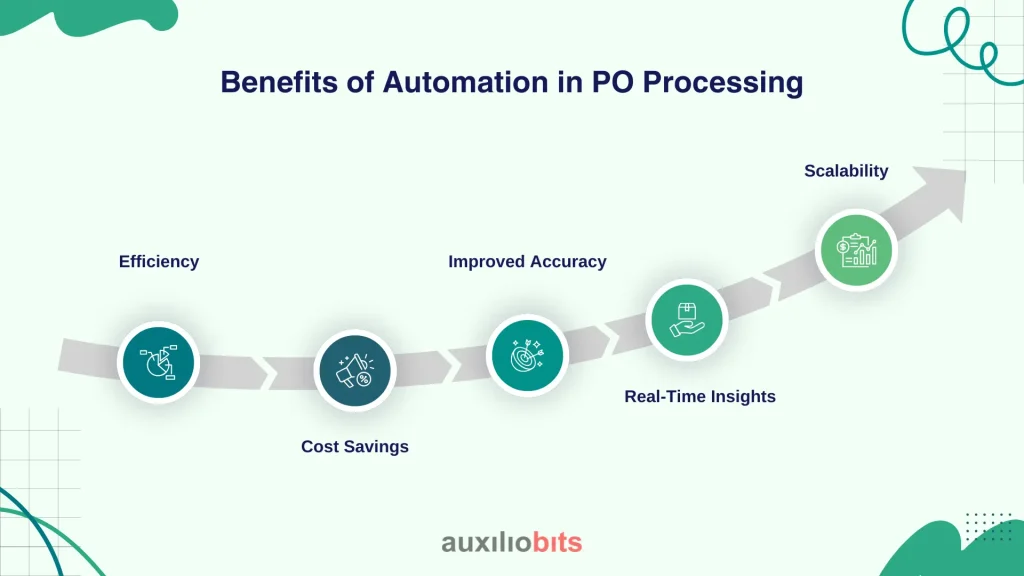
Key Takeaways
- Procurement teams lose valuable time and money due to manual tasks, human errors, and a lack of visibility across the lifecycle.
- Requisition to supplier award, automation eliminates bottlenecks and enhances decision-making.
- Up to 70% faster PO cycles, 95% fewer errors, and substantial cost savings through reduced labor and better supplier selection.
- Organizations gain greater control over spending patterns, supplier performance, and process compliance.
- The global retailer case study shows a 60% reduction in PO processing time, 20% cost savings, and improved customer satisfaction—proving the strategic value of automation.
Procurement teams are constantly being asked to produce efficiency, accuracy, and cost savings from the procurement process and are doing everything they can to prove they can work within tight deadlines. But, no matter how quickly procurement teams process and manage purchase orders (POs), manual PO processing, with its time-consuming tasks, risk of human errors, and delayed PO processing, will inevitably lead to rework and disappointment.
Can you imagine a procurement cycle that is done for the purpose of providing the procurement team with instantaneous validation on requisitions, awaiting seamless approval via a procurement governance and approval process? And awarding the request of a supplier in hours and not days? This is the promise of Smart PO processing—a whole new way of thinking about the procurement lifecycle.
Smart PO processing utilizes modern technology, including Artificial Intelligence (AI), Machine Learning (ML), and Robotic Process Automation (RPA), to automate each step—from requisition, approval, supplier award, and prediction of supplier performance.
By using Smart PO processing to eliminate manual labor, reduce human error, and streamline decision-making, an organization can:
- Save procurement teams’ time
- Save money
- Enhance operational risk visibility.
- Improve planning and performance.
Also read: Why Procurement in Manufacturing Still Runs on Emails: A Deep Dive into Manual Vendor Management?
The Challenge with Manual Purchase Order Processing
Manual purchase order processing continues to be a sizable issue for many organizations. Procurement teams still resort to outdated tools like emails, spreadsheets, and paper forms. These processes create inefficiencies that harm business performance:
Time-Intensive Processes:
Manual data entry, multi-level approvals, and repetitive work slow down procurement. Processing a single requisition can take days.
Typos, miscalculations, and missing information lead to:
- Wrong orders
- Delivery delays
- Compliance issues
- Rework and increased resource use
Lack of Visibility:
Siloed systems mean:
- Difficulties in tracking requisitions
- Inability to monitor supplier performance in real time
- Missed cost-saving opportunities
Inconsistent processes and missing audit trails increase the risk of:
- Policy violations
- Regulatory fines
- Reputational damage
Manual tasks = higher labor costs. Employees spend time on:
- Reissuing POs
- Reconciling invoices
- Fixing errors
These issues:
- Hinder speed and efficiency
- Strain supplier relationships
- Reduce organizational agility
- Become bottlenecks as businesses scale
The Solution: Smart PO Processing Automated
Smart PO processing redefines the procure-to-pay lifecycle by automating the entire process—requisitioning, approvals, PO generation, and supplier awarding.
It integrates RPA, AI, and ML to:
- Automate tasks
- Improve accuracy
- Enable faster, smarter decisions.
Smart PO Processing Elevates Procurement by:
- Transforming it from an administrative to a strategic function
- Adding measurable value across the organization
Components of Smart PO Processing
The important components of smart PO processing are:
1. Automated Requisition Management:
- Employees submit requisitions using a user-friendly digital interface
- Eliminates paperwork
- Reduces manual entry errors
2. Supplier Selection and Awarding:
- AI reviews supplier data: pricing, performance, reliability
- Recommends the most suitable supplier
- Automated RFQs and bidding speed up the process
- Smart contracts:
- Enforce agreed terms
- Speed up transactions
- Reduce disputes
Benefits of Automation in PO Processing
The perks of automation in PO processing are as follows:

Efficiency
- Reduces processing time by up to 70%
- Suppliers are awarded faster.
- Projects will be completed soon
Cost Savings
- Minimizes labor costs
- Prevents overpayment and manual error-related expenses
Improved Accuracy
- AI validation ensures POs match order details.
- Prevents costly mistakes
Real-Time Insights
Dashboards visualize:
- Requisition status
- Supplier performance
- Spending patterns
- Supports high transaction volumes
- No need for additional staff
Why Automation Is the Future of Procurement
Smart PO processing is no longer a trend—it’s essential. Automation frees procurement teams from:
- Busy, repetitive admin tasks
- Allowing more focus on:
- Supplier relationship management
- Strategic sourcing
- Cost reduction initiative
Analytics drive:
- Better visibility into spend patterns
- Better contract negotiation
- Quicker response to market changes or supply chain disruptions
During supply shortages, AI identifies qualified suppliers in real time—keeping operations running smoothly. Digital transformation is now a top priority, and smart PO processing helps procurement become a strategic enabler of that transformation.
Case: Streamlining Procurement for a Global Retailer
The Challenge
- Email
- Spreadsheets
- Paper requisition forms
This caused: - Approval Delays (5–7 days)
- Inventory errors impacting customer orders
- No visibility into supplier performance
- Over-spending and missed opportunities
- High operational costs due to inefficiencies
The retailer aimed to:
- Improve productivity and efficiency
- Reduce errors
- Scale supplier management
- Support global expansion
The Solution
The retailer partnered with Auxiliobits to deploy Smart PO Processing using AI and RPA.
Key Implementations:
RPA Bots
- Automated data extraction and PO generation
- Reduced document workload by 80%
- Checked POs against:
- Budgets
- Policies
- Inventory needs
- Flagged discrepancies for human review
Centralized Dashboard
- Provided real-time requisition tracking
- Delivered insights into spend trends and supplier performance
Supplier Analytics
- AI compared bids based on:
- Cost
- Delivery
- Reliability
- Helped award POs quickly and competitively
Results
Within six months, the retailer achieved:
- 60% Reduction in Processing Timings
- Requisitions approved and POs issued within 24 hours.
- Faster restocking, improved customer satisfaction
- 95% Error Reduction
- Accurate orders
- Fewer returns
- 20% Cost Savings
- Lower labor cost
- Optimized supplier selection
- Improved Supplier Relationships
- Faster communication
- Data-driven decisions
This case proves that Smart PO Processing delivers measurable ROI—applicable across industries like retail, manufacturing, and healthcare.
Conclusion
Are you ready to take your procurement process to the next level? Smart PO processing can pare down time and cost and give your organization a strategic edge. Get in touch with us to learn more.








